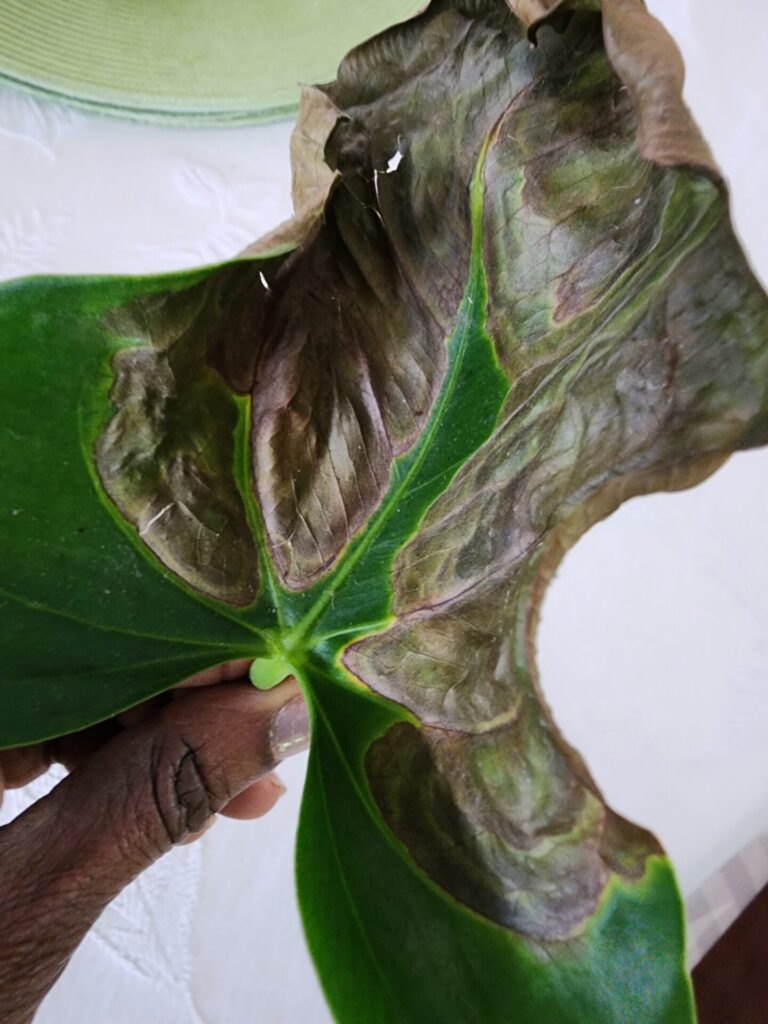
My anthurium leaves are turning brown and dry. The plants die after a while. The blooms wilt and die and do not last long. Plants are indoor near to the window to get a bit of indirect sunlight during the day. They are planted in potting soil. What would cause this and how do I prevent it?
Thank you for contacting the Toronto Master Gardeners about your ailing anthurium (likely Anthurium andraeanum, the most common type). Based on your photo, it looks like the damage on the leaves of your plant could be the result of environmental factors and/or cultural practices that are not favourable for your anthurium, or the cause could be disease. I do not think that the cause is insects, however, I suggest that you first inspect your plant thoroughly (with a magnifying glass) for insects and evidence of them eg. insects crawling or flying on or near your plant, webbing, stickiness). If you do see evidence of insects, and your plant is near other plants, you should isolate the anthurium to prevent the insects from spreading to other plants. Common insect pests include spider mites, mealy bugs and scale, which can usually be controlled by spraying the plant with water, or with applications of insecticidal soap (or rubbing alcohol for scale) or horticultural oil.
Overwatering houseplants is a common problem which can cause root rot. I suggest that you check the roots of your plant for discolouring (brown, black, yellowish) especially at the tips, and for mushiness. Any rotten parts should be cut away, and the plant repotted, in a pot with drainage holes. Regular houseplant potting soil is not ideal for anthurium. These plants prefer a loose, well-draining growing medium. An orchid mix with some additional sand and/or peat moss would work well. Watering should be done when the top inch or so of the soil feels dry. Anthurium likes consistent moisture. It does not like to completely dry out, or to be soggy.
Anthurium prefers bright indirect light. Since it sounds like your plant is blooming, its spot by the window could be a good one, as long as there are no drafts (these plants like to be warm, 18 degrees Celsius minimum). Anthurium also prefers high humidity, so if needed, you could consider running a small humidifier nearby.
The damage on the leaves of your anthurium could also be the result of systemic or localized bacterial disease. Over time, systemic bacterial disease will affect other parts of your plant in addition to the leaves, resulting in stem rots, leaf blights, wilts and root rots. If other parts of your plant also appear to be infected, it could be that your plant had this disease when you bought it (the greenhouse where it was growing could be a source). Unfortunately control strategies for systemic bacterial disease are very limited, so discarding and replacing infected plants is often the best approach. On the other hand, if this damage appears only on the leaves of your anthurium, it could be a localized bacterial disease. This disease can be controlled by cutting away the infected leaves as soon as you see evidence of this damage, to prevent spreading to other leaves. Wash your hands and clean your cutting tools with 70% alcohol after removal of these damaged leaves.
Hopefully the problem with your anthurium can be managed with some changes to its environment and/or your cultural practices, including how often it is watered. Here are a couple of links to websites with further information about caring for your plant.
Anthurium: A Complete Guide to Growing Anthuriums
Best of luck at restoring your lovely plant to full health!

